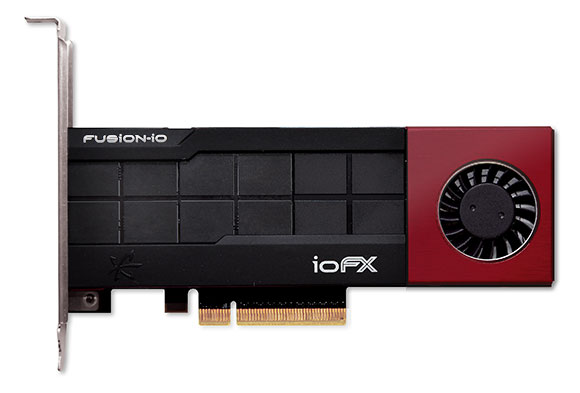Fusion IO, well known for their high performance, professional grade solid state drives and more recently, SSD caching solutions, has announced the release of their ioFX PCIe SSD.
Part of their ioMemory platform, ioFX is intended to bring cost effective, souped up data storage to the workstation.
The drive will deliver 1.5GB/s, and will allow artists to manipulate prodigious amounts of digital video without the need for a massive storage array.
What I find interesting about this release is the fact that it comes so soon after Intel’s announcement of their new 910 PCIe SSD. Considering both products could conceivably be used in similar scenarios, it seems likely that there’s a certain amount of posturing taking place between these would be competitors. It’s true, when one considers the relative price and performance parity of both of these products, it appears we may be witnessing the expansion of another market segment which stands to reap big benefits from SSDs, which are a very natural fit for applications that require exceedingly fast data transfer.
Specifically, when dealing with enormous, uncompressed video files, speed is of supreme importance if creative minds wish to keep a schedule that doesn’t run into next century. Streaming HD this is not, with uncompressed 2k and 4k content often commanding a bitrate greater than 6Gbps, overwhelming even the most efficient SATA SSDs. Considering the perfectly pristine nature of these masters, it is eminently understandable that they would need to maintain such a large foot print, their quality putting even Blu-Ray’s clarity to shame, but I digress. The take home point here is that when it comes to content creation and state of the art digital media, PCIe SSDs aren’t merely a convenient extravagance, they’re absolutely essential.
Another area in which ioFX should be significantly helpful is in 3D rendering, acting as a sort of giant frame buffer which should serve to accelerate the raytracing process, which has almost completely overshadowed rasterization in films utilizing 3D animation. With its ability to provide a smooth stream of data to a software renderer, ioFX will substantially cut down on the time it takes to transition from concept to culmination, allowing artists to view their final creations with significantly less turnaround. Indeed, it seems that PCIe SSDs really may end up being the cutting-edge canvas modern day Michaelangelos’ rely on in order to realize their latest masterpieces, MLC being the basis for today’s REAL modern art.
I have to say, with new PCIe SSDs being released seemingly every week now, I can’t help but wonder when we might see them supplant their comparatively conventional SATA based siblings. Seeing as more and more applications are now relying on these speed demons out of necessity, it seems that anything slower than the new status quo will very likely be squeezed out of the market, making way for something that’s better able to manage major workloads. Right now, this situation is relegated to the professional realm, but recognizing that many consumers now view SSDs as being consummate elements of any new computer, it may only be a matter of time until we see the mass proliferation of PCIe based SSDs – slower SATA variants being considered par for the course.
With any luck, what we are witnessing is a symbiosis of sorts, in which creativity can help drive the insatiable craving for constantly improving hardware. Such ‘mutual benefit’ could be construed as foreshadowing the existence of a burgeoning market for manufacturers to ‘latch on to’, signaling the next ‘evolution’ of the SSD industry. By adopting a ‘cleaner’ interace, PCIe SSDs look to be prime candidates when it comes to ‘fish’ing for consumers’ hard earned finances.
I know I wouldn’t mind having a ‘dependence’ on such decisive performance!
See Press Release On Next Page………
 The SSD Review The Worlds Dedicated SSD Education and Review Resource |
The SSD Review The Worlds Dedicated SSD Education and Review Resource | 


The problem i see with these drives is that they still are expensive, for less u could get 8 vertex3 max iop drives and a lsi 9265 raid and raid5 the lots of them. The only downfall would be the seak time.